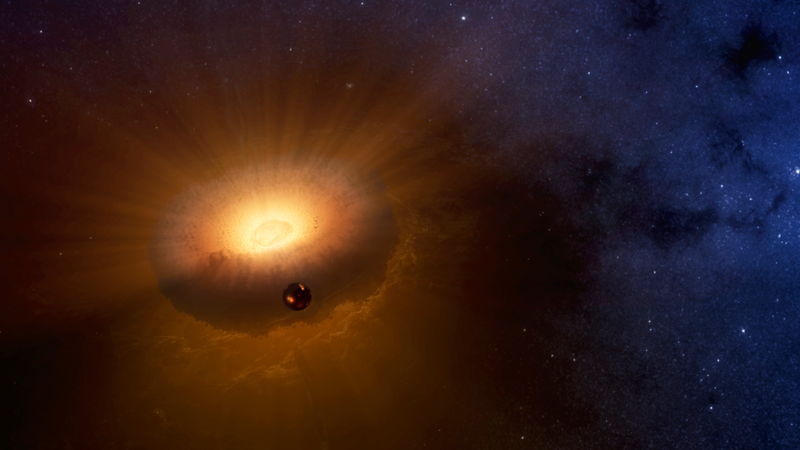
A favorite pastime of astronomers is to debate the origin of Earth’s Moon, but despite decades of research, they don’t seem to be any closer to reaching a consensus. Scientists have now added a new theory to mix—and it’s weird as hell. The Moon, they argue, formed inside a gigantic donut-shaped cloud of vaporized rock that would eventually condense into the Earth.
The Moon, it has been argued, was captured by the Earth’s gravity billions of years ago. Alternately, the Earth and Moon formed together as a binary system within the Sun’s protoplanetary disk. Or, a rapidly spinning Earth, in an example of cosmological-scale fission, ejected a huge blob of its mass, producing the Moon.
The prevailing theory for the Moon’s origin, however, suggests a Mars-sized object, dubbed Theia, ploughed into a young version Earth about 4.5 billion years ago. It was more of a glancing blow, and the collision threw tons of molten rock and metal into Earth’s orbit. Eventually, all this matter congealed together, forming the Moon. A 2014 study suggested that traces of the hypothetical Theia have been detected in lunar samples, bolstering the “giant impact hypothesis” even further.
Trouble is, while certain chemical characteristics of the Moon and Earth are very similar, there are some important differences. Researchers at the University of California-Davis and Harvard have posited a new theory of lunar formation that matches the exact pattern of the Moon’s composition. The new paper, led by UC Davis astronomer Sarah Stewart, was published today in the Journal of Geophysical Research: Planets.
Their theory involves an entirely new type of astronomical object called a synestia (no, not synesthesia, that’s something entirely different). The word is an amalgam of “syn”, meaning “together,” and “Hestia,” the Greek goddess of architecture. The idea was first proposed in 2017 by Stewart and Simon Lock of Harvard University, a co-author of the new study.
A synestia happens when young, planet-sized objects smash into each other, creating a rapidly spinning mass of molten and vaporized rock. Significant portions of this volatile cloud orbits around itself, and it puffs out into an object that looks like a gigantic donut floating in space. A synestia only lasts about 100 to 200 years, shrinking quickly as it loses heat. The rock vapor first condenses into a liquid, and then into a molten planet.
“A synestia is an astronomical body that exceeds the rotation limit of a planet,” Stewart told Gizmodo. “Synestias are created by the high energy and high angular momentum of a giant impact.”
Stewart and Lock hypothesize that Earth, and perhaps many other rocky planets, start off this way. It’s important to note, however, that astronomers have never actually seen such a thing—it’s a purely hypothetical object. But models run by the researchers suggest its possible.
According to this latest research, the Moon may have formed within the Earth-synestia. Following a collision and the formation of the synestia, a “seed” formed within it from chunks of molten rock. As the Earth-synestia began to shrink, vaporized silicate rock began to rain onto the proto-Moon. Eventually, the Moon emerged as a discrete celestial object, trailing its own atmosphere of rock vapor.
“Our model starts with a collision that forms a synestia,” Lock said in a statement. “The Moon forms inside the vaporized Earth at temperatures of four to six thousand degrees Fahrenheit and pressures of tens of atmospheres.”
This explains why the Moon and Earth share certain features, including strikingly similar geochemical attributes and isotopes. But it also explains why the Moon is missing certain elements, including volatile elements such as potassium, sodium, and zinc. The Moon lost its easily vaporized elements due to the extreme temperatures produced within the synestia, which nicely explains its distinct composition.
“Our new model predicts the pressure and temperature range for the rock vapor environment around the growing Moon. Our model can be tested by future calculations of the elemental and isotopic composition of a Moon that forms under these conditions,” said Stewart. “We predict the abundance of several moderately volatile elements in this paper, but these calculations should be expanded to include more elements and to push for more accurate measurements of the composition of the Moon.”
Needless to say this is a highly theoretical explanation. Astronomers still need to prove that synestias are actually a thing before they can claim that they give birth to natural satellites. To that end, scientists should look for synestias around young stars, sample lunar materials, and continue to refine their models.
This post was updated to include the comments made by Sarah Stewart.
[Journal of Geophysical Research: Planets]
https://gizmodo.com/freaky-new-theory-offers-totally-new-explanation-of-the-1823388484Bagikan Berita Ini















0 Response to "Freaky Theory Offers Totally New Explanation of the Moon's Origin"
Post a Comment